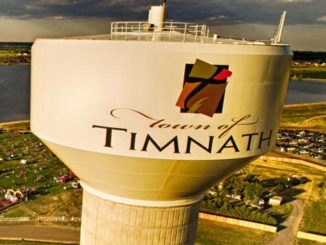“Tears for children never grown,
Long-dried amongst the toppled stones,
As today becomes tomorrow’s past,
Blend in with our own.
Though we forget, they’re not gone.
And time marches on.”
Nearly 50 percent of Timnath Cemetery’s history rests upon children’s bones buried in the graveyard. The 1996 book “Timnath” by Del Miller and Elsie Fisher, published by The Columbine Club of Timnath, details the town’s history up to that year. A large portion of one chapter is dedicated to the identities of the people buried in Timnath’s only cemetery, officially founded in 1888 when approximately two acres of H.H. Scott’s land were deeded to the Trustees of Timnath Presbyterian Church.
Tragically, of the approximately 70 people buried on the rocky knoll between 1886 and 1933, 31 were infants, some stillborn, and children under age 10. But even those graves without markers were treated respectfully through ongoing grounds maintenance while family members occupied the Scott homestead. Church members donated funds and family members tended graves.
As is quoted in “Timnath” from an 1889 John Willis diary entry, “Wind blew hard in the forenoon. Luella & I fixed up Laura’s and Frankey’s grave & sat out sum liles.”
Willis’s handwritten, touching recollection about his children’s burial spot indicates that people once respectfully maintained final resting places, even in inclement weather.
The Rudolph family purchased the Scott homestead in 1964, repaired the fencing between their field and the cemetery, but found the fence and gate bordering the road — and the cemetery itself — in deplorable condition. Time, weather and vandalism had brought down tombstones. Others had been stolen. Gravesite identification was impossible in some cases.
Fannie Rudolph reported the terrible disrepair to the Columbine Club of Timnath and club women immediately voted to make cemetery restoration their special project. Preliminary cleanup began one Saturday in October 1964, when even Timnath schoolchildren helped clear away dead weeds and trash. Men brought a variety of tools and materials which they used to repair broken picket fencing, fallen and/or broken gravestones, and one nearly intact wooden cross.
The crew removed early hitching racks, the old stile, and a wooden arch, all of which were beyond restoration. As they replaced broken posts, their labors brought sober reflection about men who dug one early grave in a particularly rocky spot. “Timnath” states that Alta Lewis Bush recalled that deep hole was hand-dug with shovels by men working round-the-clock for nearly two days! Life then was very hard and tending to death’s necessities apparently offered survivors little reprieve.
A dedication service planned for May 23, 1965, on cemetery grounds was moved inside to the church sanctuary due to a heavy shower that blew in just before the appointed hour. It’s noted that many older people with ties to the community traveled from distant points to attend the ceremony.
Strolling through knee-high weeds in December 2014 while dodging fire ant mounds, rodent holes, and markers sinking into graves left no doubt about the present sad condition of the cemetery.
Nearly 50 years after residents lovingly restored and dedicated it, no dedication remains save for that of visitors to just a couple graves. Two tiny American flags (one laying in the dirt) had been left, as had two artificial flower bouquets. Tall grass, brush and tumbleweed so-obscured the grounds that, especially from the less-traveled road, it’s nearly impossible to tell the small acreage is a cemetery.
Are the lives and deaths represented in those untended plots worth consideration? The Columbine Club book pieced together sparse details of some. Those of little children are the most poignant. A few (paraphrased) follow.
Ora Morgan- Born in December 1898, died April 22, 1905. Upon arriving home from school, the 6-year-old called and waved to his mother sitting at the window sewing. Then he worked on a swing he was building in a tree within sight of the window. One end of the rope was already secured to the tree. Young Ora climbed to attach the other end to a limb.
His mother glanced up and saw him on his knees under the swing. The next time she looked he was still in the same position so she went out to check on him. Her darling, energetic son was dead. Apparently Ora had fallen from a limb with the rope wound around him and it had caught around the little boy’s neck.
Just a few of the other children interred in Timnath Cemetery are Vernador Chagolla, who died Aug. 19, 1912 of whooping cough at age 2 months; Victor Galligoes, Feb. 12, 1912, 9-years-old, bronchial pneumonia; Jenetta Soto, Oct. 5, 1911, 1-year-old, typhoid; three Carshrud children, 1895, drowned in a boat accident. Sixteen-year-old Walter Smith died April 20, 1891, from croup. In “Timnath” it says that Walter was a favorite in the community and a leader of Christian Endeavor, the church’s young people’s society. “Asleep in Jesus” is etched at the bottom of his tombstone.
The souls whose bodies lay within Timnath’s historic and only cemetery likely never imagined how their lives would end. Grieving family members and friends likely never imagined that graves they painstakingly dug and tended would ever fall victim to such ravages of apathy. Perhaps even vandals no longer visit.
Timnath Cemetery is located on the rise of the first hill at 5341-5389 E County Road 42E (off CR5 just south of Prospect Road, or about 2 miles north of Old Town Timnath). A black iron fence denotes the entrance to the graveyard.
Support Northern Colorado Journalism
Show your support for North Forty News by helping us produce more content. It's a kind and simple gesture that will help us continue to bring more content to you.
BONUS - Donors get a link in their receipt to sign up for our once-per-week instant text messaging alert. Get your e-copy of North Forty News the moment it is released!
Click to Donate


